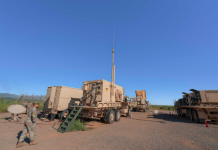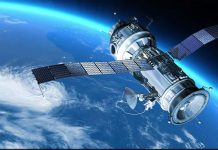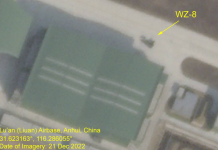Just as medieval mariners used the North Star as a focal point to traverse the open ocean, future astronauts and spacecraft may well rely on pulsars for positioning, navigation, and timing (PNT) in deep space — a capability now being honed by researchers at the US Naval Research Laboratory.
“There’s been celestial navigation forever, mainly looking at the angles of stars. That’s how a sextant works or tells you where the stars are. This is a different one: it’s using clocks in space,” Paul Ray, head of NRL’s High Energy Astrophysics and Applications Section, told Breaking Defense in an interview Monday.
Those “clocks” are pulsars, “collapsed stars that have become neutron stars — that are really dense collapsed stars — that are spinning and emitting beams of radio waves and other radiation that cross by the Earth, and make blinks of light,” Ray explained.
The concept is in some ways a simple one, despite the decades of research using multiple sophisticated telescopes and reams of complex mathematical calculations that have gone into proving its feasibility. Receivers would detect, measure and use those regular pulses of radiation emitted by pulsars every few milliseconds in lieu of the atomic clocks now carried by Global Positioning System (GPS) and similar satellites. Exquisitely precise, atomic clocks provide timing signals to allow receivers to determine their distance from the GPS satellites, and in turn calculate their latitude, longitude and altitude.
Operators, whether commercial or military, need to know precisely where their spacecraft is in order to ensure that platforms and devices on the ground, in the air, at sea or elsewhere in space can reliably receive downlink signals carrying data — not to mention when anyone spacecraft is in range of a ground control station so as to send uplink signals telling the spacecraft what to do.
For the moment, instruments for detecting pulsar blasts are based on X-rays, which do not penetrate the Earth’s atmosphere, making them useful only in outer space, Ray explained. However, he didn’t rule out the possibility that someday those X-ray signals might be converted and relayed to terrestrial platforms.
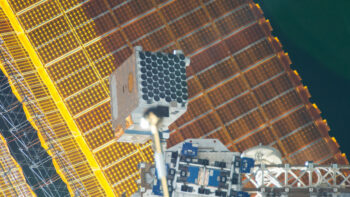
NASA’s Neutron-star Interior Composition Explorer (NICER) X-ray telescope on the ISS. (NASA)
While astrophysicists have discovered thousands of pulsars, Ray said only “six or seven” have been located that can provide signals that are regular enough and strong enough to measure in the short period of time required for precise PNT functions.
That said, Ray explained, even that small number could in future allow reliable navigation through the cosmos.
NRL already has been part of an ongoing feasibility demonstration led by NASA that has been flying since 2017 on the International Space Station, using an experimental X-ray telescope to characterize the properties of neutron stars. The telescope, called the Neutron star Interior Composition Explorer (NICER), is about the size of a washing machine and carries an array of 56 small mirrors, each as big as a CD disc, Ray said.
The team coupled NICER with flight software under a mission fittingly called Station Explorer for X-ray Timing and Navigation Technology (SEXTANT) to use the observations of X-ray pulsars to determine the space station’s orbital position. The SEXTANT team successfully completed the first demo in November 2018.
“NICER’s normal day-to-day work is studying neutron stars for their astrophysics applications, but we commandeered it for several days and had it point only at specific pulsars,” Ray said. “We did the first demonstration of this real time, on orbit, totally autonomous navigation using only observations of pulsars.”
Meanwhile, NRL researchers are working on discovering new “millisecond pulsars” to use as clocks, as well as contributing to research to hone pulsar PNT technologies and capabilities to the point they could be used in the real world.
On June 28, the lab announced that international scientific collaboration, including its Space Science Division, had successfully used pulsar observations to discover new evidence of “gravitational waves that stretch and squeeze spacetime.” (Gravitational waves, thought to be created by super-massive black holes, were first predicted by Albert Einstein in 1916 and proven to exist almost 60 years later by the National Science Foundation’s Laser Interferometer Gravitational-Wave Observatory.)
Ray explained that the discovery that gravity waves have a small effect on the frequency of pulsar “pulses” also is important for understanding the limitations of these celestial clocks, although he stressed that the distortion created is so small as to be negligible for routine PNT purposes.
“It’s not any sort of killer flaw,” he said.
Next Steps Toward Next-Generation Celestial Navigation
In order to build a working pulsar PNT network, Ray said there are several avenues that need greater development.
The first is to “increase the number of clocks,” he said. “We want to find more pulsars, right, characterize them as clocks and understand their emissions. So that’s giving us that input signal.
“Then on the detector side, I would say, ‘can I make a robust detector system that’s as small as practical, keeping in mind that we have to have a certain amount of frontal area to collect those photons. … But, you can improve the background of your instrument. You could shrink down the size of your instrument to a certain extent. You could use less power; you can optimize the design for space. But it’s not a quantum change from what’s been done.”
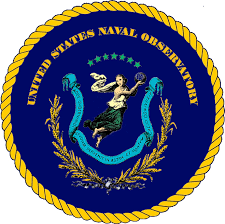
The U.S. Naval Observatory Seal, designed in 1867 by RADM Charles Henry Davis. (USNO)
And in case anyone is wondering why NRL is undertaking such research, rather than the Space Force itself, it is actually the Navy that is the official timekeeper for the Department of Defense.
The US Naval Observatory “maintains the clocks,” Ray said, “that is, the time system kept by the Naval Observatory defines the time for all the DoD, and they also keep the celestial reference frame, the stars that define where everything is in space that’s required for all sorts of naval systems that need to do geolocation.”
NRL itself further has a long history of work to develop and perfect atomic clocks, including those used by GPS.
“NRL has an entire branch, our Naval Center for Space Technology, that does long-term studies of the clocks they use for GPS,” Ray aid. “And so, NRL has had an industry of characterizing and understanding those clocks.
“Similarly, we are trying to characterize and understand these celestial clocks. And it turns out that many of them are as stable as laboratory atomic clocks. They’re extremely good clocks on long timescales. They don’t drift much at all. In some cases they don’t drift measurably, as far as our measurements show,” he added.
“Clocks are important,” Ray summed up, “and you better know what your clocks are doing all the time.”



